Hand is not only a direct tool for labor production, but also the first tool for labor production. Once formed, it cannot be regenerated, and it is difficult to repair the strain. Therefore, it is very important to choose suitable gloves for safety protection. This article describes in detail the commonly used laboratory gloves and their use.
Only the first layer of safety protection for laboratory gloves, but should pay attention to maintenance. In the laboratory, the common effects of gloves are classified into: non-slip (matte), heat insulation, mechanical damage prevention, curing (no powder), and chemical resistance.In the common gloves for laboratories, primary protection focuses on heat insulation and mechanical damage, and weaving gloves are used; professional-grade protection focuses on chemical corrosion; the maintenance level emphasizes that gloves do not cause dry skin, irritation, allergies, and even slow hand wound healing. .
Primary protective gloves: woven gloves made of knitted fabrics, leather, or synthetic materials; cut-resistant gloves with Kevlar material, Dyneema material, and steel; with thick leather, special synthetic coating Layer, insulation cloth, glass wool heat gloves.
Scope of protection: It is used for anti-wear, piercing, cutting, heat insulation, working in high-temperature environment, etc.
Professional-grade protection: Chemicals and agents that are irritating to the skin are easy to injure the hands during opening and use, and are professionally protected according to the characteristics of chemical substances.
Natural rubber (latex): Natural latex is collected from tropical rubber trees, latex is milky white, high elasticity is not easily deformed, long-term resistance is not easy to break; natural rubber is a natural polymer compound with polyisoprene as the main component, mainly used In the tire industry.
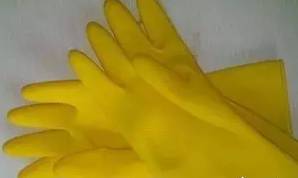
It can provide effective protection against alkalis, alcohols, and a variety of chemically dilute aqueous solutions, and can better prevent the corrosion of aldehydes and ketones. However, after the use of gloves, the handleability is not good.
Polyvinyl chloride (PVC): polyvinyl chloride resin formed by the polymerization reaction of polyvinyl chloride resin, processed and prepared.

Strong anti-chemical corrosion resistance, almost all chemical dangerous goods can be protected, anti-static properties, applicable to dust-free environment. Operating temperature range: -4 °C ~ 66 °C; high temperature 80 ~ 85 °C, began to soften, high temperature decomposition of vinyl chloride (VCM) toxic.
Polyethylene (PE) Gloves: Polyethylene resin is formed by the polymerization of vinyl monomers and processed. Differences with polyvinyl chloride (PVC): Polyethylene plastic bag products are non-toxic and can hold food; polyvinyl chloride (PVC) plastic bags are toxic and cannot contact food.
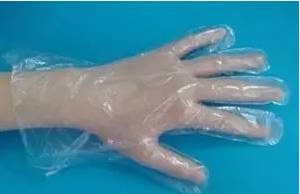
Disposable gloves, can not be high temperature, with waterproof, anti-oil, anti-bacterial, acid and alkali-resistant functions; glove operating price, but poor ventilation, sweat and other volatile out.

Nitrile rubber gloves: Nitrile rubber is prepared by emulsion polymerization of butadiene and acrylonitrile. The material has excellent oil resistance, high wear resistance, good heat resistance, and strong adhesion. However, poor low temperature resistance, poor ozone resistance, poor insulation, and low elasticity.
Gloves can prevent grease (including animal fat), xylene, polyethylene and aliphatic solvents and most pesticide formulations, have a certain antistatic properties, low surface chemical residues, and are suitable for use in clean environments. Due to the poor elasticity, the use of gloves is basically a one-time use.
Neoprene gloves: Synthetic rubber produced by alpha-polymerization of chloroprene (2-chloro-1,3-butadiene) as the main raw material, resistant to oil, heat, fire, sunlight and ozone , Naisuan Jian, chemical resistance.
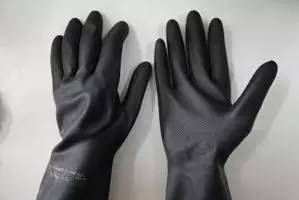
Gloves have a wide range of applications and are similar to natural rubber in terms of comfort. They have good protective effects on petrochemical products and lubricants, but they have poor cold resistance and should not be used at low temperatures. Products are also not suitable for long-term storage.
Butyl Rubber (IIR) Gloves: It is synthesized from isobutylene and a small amount of isoprene. It has chemical stability and thermal stability. The most prominent is hermeticity and watertightness. The material length is used as the inner tube of automobiles.
Due to material characteristics, it is only used as medium-sized non-lining gloves, and it is commonly used in glove box, anaerobic tank, incubator, and operation box, and it is used in hydrofluoric acid, aqua regia, nitric acid, strong acid, alkali, toluene, alcohol, etc. Super durability.
Polyvinyl alcohol (PVA) gloves: Polyvinyl alcohol, organic compounds, white flake, floc or powdery solid, odorless. Soluble in water (>95°C).
It provides high levels of protection and corrosion resistance against a wide range of organic chemicals such as aliphatics, aromatics, chlorinated solvents, fluorocarbons and most ketones (except acetone), esters and ethers.
appendix:
Table 1 Pros and Cons of Various Material Gloves
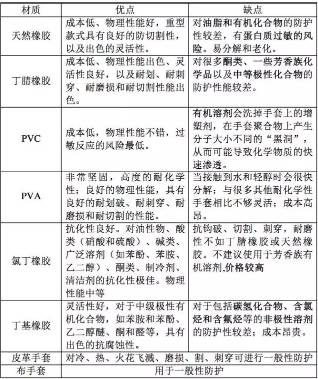
Table 2 Various materials gloves anti-chemical performance table
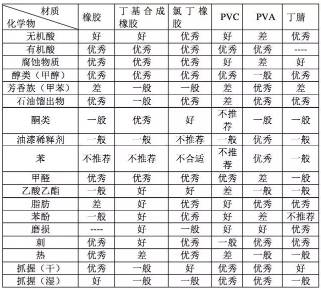
Reference article:
[1] Xia Yuyu, [M] laboratory technician practical manual. Beijing: Chemical Industry Press, 1999: 81-82.
[2] Nelson Schlatter, Finding the Right Glove [J], Experiments and Analysis, 2009.1:50-52
[3] Li Haixia. Selection of protective gloves [J], China Personal Protection Equipment, 2004.6:37
[4] Cai Xin, Zhou Ming, Basic characteristics and selection criteria of protective gloves [J], China Personal Protection Equipment, 2003.3:27-29
[5] Chen Shaoying, Safety Protection in Chemical Laboratory [J], Chemistry Education, 2007.10:44-46
[6] Zhao Jingjing, etc., on the gloves of the chemical laboratory [J], Science and Technology Innovation Review, 2011: 128-129
[7] Yang Ling, Discussion on Personal Protection in Chemical Laboratory, [J], Laboratory Research and Exploration, 2011: 236-238
Diamond Electroplated Grinding Wheel
DIY,special
Guanghan Longrun Science and Trade Technology Trade Co., Ltd. , https://www.kairungongju.com